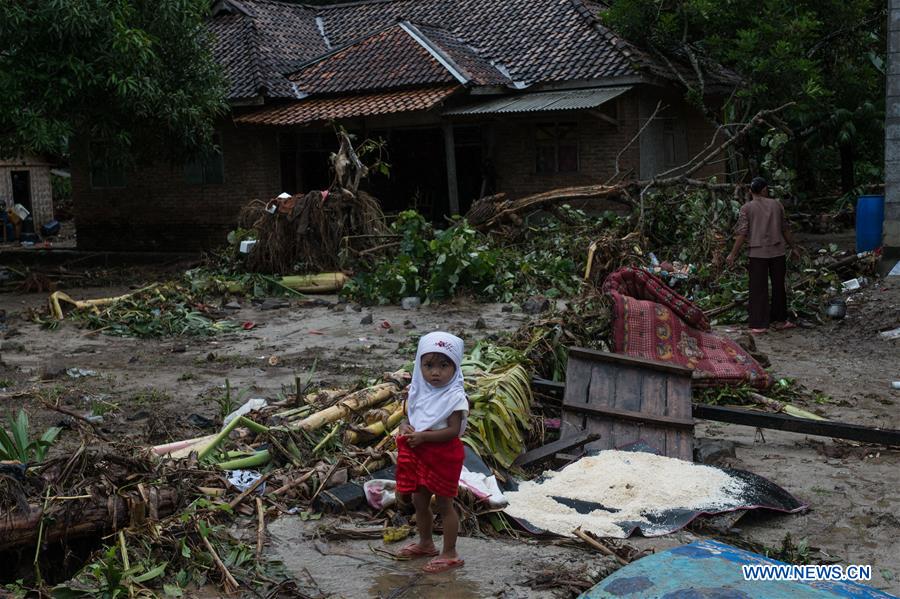


A child stands in tsunami debris at Tanjung Lesung district of Pandeglang, Banten Province, Indonesia, Dec. 25, 2018. Casualty from the tsunami triggered by a volcanic eruption in Sunda Strait in Indonesia climbed to 429 people on Tuesday, spokesman of national disaster management agency Sutopo Purwo Nugroho told a press conference. (Xinhua/Veri Sanovri)
JAKARTA, Dec. 25 (Xinhua) -- The death toll from the tsunami triggered by a volcanic eruption in Sunda Strait of western Indonesia has climbed to 429 so far, with a total of 1,459 others injured, a spokesman of the national disaster agency said on Tuesday.
The tsunami, triggered by an underwater landslide after the eruption of Anak Krakatau volcano Saturday night, destroyed 882 houses, 73 hotels and villas and scores of buildings along the coastlines, and displaced a total of 16,082 people, according to spokesman of the National Disaster Management Agency Sutopo Purwo Nugroho.
The search and rescue mission was conducted both onshore and offshore along the strait between Java and Sumatra islands, as many victims were believed to be swept away by tidal waves into the sea, the spokesman said.
"Ships searching the victims have already retrieved several bodies in the sea," Sutopo told a press conference at the agency's headquarters.
The disaster also destroyed a sea port, and 434 ships and boats in the worst-hit Pandeglang and Serang districts in Banten province, and Lampung Selatan, Panawaran and Tenggamus districts in Lampung province.
Over 2,000 soldiers and police, along with personnel from the search and rescue office and the disaster management agency office as well as volunteers, were participating in an emergency relief operation, which still put a priority on the search and rescue of the victims, Sutopo added.
Heavy machinery equipment, tents and other necessities were badly needed in the emergency relief, he said.
"The absence and failure of early tsunami warning systems have contributed to the huge casualties because people have no opportunity to be evacuated," Sutopo said.
Mt. Anak Krakatau is surrounded by several tourist resorts, an industrial zone, a busy shipping lane and some residential areas, making the early warning system crucial in case of a tsunami.
High waves of 4-5 meters slammed into the shore on Saturday night without any early warning, Endang Permana, head of emergency department of the disaster management agency in the district, told Xinhua.
The meteorology and geophysics agency has banned activities in the coastal areas after the deadly tsunami, as the assessment of volcanic eruption risk was being taken, said Sutopo.
On Dec. 26, 2004, a massive tsunami triggered by a powerful quake hit countries along the Indian Ocean, killing 226,000 people, including 170,000 in Aceh province of northern tip of Indonesia's Sumatra island.
Anak Krakatau, or Child of Krakatoa, is one of the 129 active volcanoes in Indonesia, a vast archipelagic nation home to 17,500 islands, sitting on a quake-prone zone of so-called "the Pacific Ring of Fire."
It is the remnant of Krakatau volcano that collapsed into small volcanic islands after a ferocious eruption in August 1883, which also prompted a devastating tsunami that killed more than 36,000 people in Banten.

 Award-winning photos show poverty reduction achievements in NE China's Jilin province
Award-winning photos show poverty reduction achievements in NE China's Jilin province People dance to greet advent of New Year in Ameiqituo Town, Guizhou
People dance to greet advent of New Year in Ameiqituo Town, Guizhou Fire brigade in Shanghai holds group wedding
Fire brigade in Shanghai holds group wedding Tourists enjoy ice sculptures in Datan Town, north China
Tourists enjoy ice sculptures in Datan Town, north China Sunset scenery of Dayan Pagoda in Xi'an
Sunset scenery of Dayan Pagoda in Xi'an Tourists have fun at scenic spot in Nanlong Town, NW China
Tourists have fun at scenic spot in Nanlong Town, NW China Harbin attracts tourists by making best use of ice in winter
Harbin attracts tourists by making best use of ice in winter In pics: FIS Alpine Ski Women's World Cup Slalom
In pics: FIS Alpine Ski Women's World Cup Slalom Black-necked cranes rest at reservoir in Lhunzhub County, Lhasa
Black-necked cranes rest at reservoir in Lhunzhub County, Lhasa China's FAST telescope will be available to foreign scientists in April
China's FAST telescope will be available to foreign scientists in April